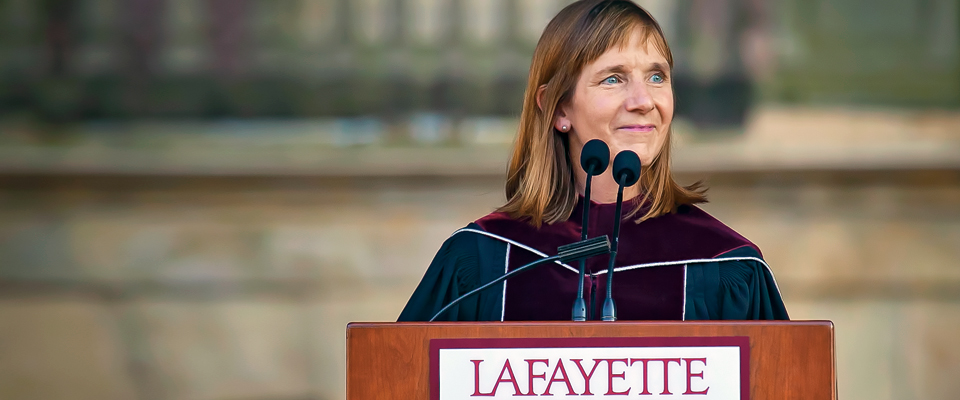
Nov 7, 2013
A Roundtable: Challenging Times for Higher Education
“Justifications of why to go to college fall into three broad categories, and each of these desirable outcomes is enhanced by the residential college…

In September, Alison Byerly, Lafayette’s first president with a Twitter account, jokingly tweeted that her Oct. 4 inauguration was shaping up as a “unique event—kind of a cross between a commencement and a wedding.” Well, the celebration of Byerly’s installation as president turned out to be much, much more. It was a homecoming at a new home, a reunion and a union, an informal strategic plan with a pop music video.
The celebration began with a luncheon address by Jay Parini ’70, Axinn Professor of English at Middlebury College, where Byerly spent more than 20 years as a faculty member and more than a decade in leadership positions. Parini called “my dear old friend” a gifted scholar and administrator who mixes intelligence and warmth whether discussing online learning at a conference or football in a coffee shop.
“This combination [traditional liberal arts disciplines and programs in engineering], very unusual in a college this size, not only benefits individual students, it benefits the College by fostering an institutional ethos that grounds the disciplines of concrete problem-solving in the necessary skills of open-ended inquiry.”
—ALISON BYERLY
Lunch was followed by a roundtable on new models for higher education, including a discussion on the future of four-year residential colleges. Unique strengths of these institutions were listed by Steven Poskanzer, president of Carleton College. New academic hybrids were proposed by Jeff Selingo, editor-at-large for The Chronicle of Higher Education and author of College (Un)Bound. Elizabeth Boylan, director of STEM programs at the Alfred P. Sloan Foundation, discussed faculty workshops run by an alliance of 23 liberal arts colleges, a project Byerly was involved in as Middlebury’s provost.
The inauguration was an extended family affair. Speaker John McCardell Jr. became Byerly’s academic mentor while serving as Middlebury’s dean of faculty and president; in fact, he invited her to cross over to “the dark side” of academic administration. Currently president of The University of the South, he recalled that Byerly was “remarkably adept” at “the finer points” of everything from grant writing to gender equity in intercollegiate athletics.
“Hers is indeed an informed and articulate voice in the world of higher education and on the issues we are facing in these uncertain times. . . . With her leadership, Lafayette is equal to the task at hand.”
—JOHN MCCARDELL
In her speech, Byerly balanced the known with the unknown. Pivotal “leaps of faith” in the College’s history give her confidence in its future. In 1865, she pointed out, President William Cattell saved Lafayette from financial ruin by convincing Ario Pardee, a coal-mining magnate, to give $20,000 to a school he didn’t know located in a city he had never visited. Pardee apparently was won over by Cattell’s point that a college education should be available to the non-wealthy. In 1969, Ralph Gottshall ’27, chair of the Board of Trustees, convinced his fellow board members to vote to make Lafayette co-ed. While he loved an all-male school, he realized that Lafayette would be a better school with women and men as students.
Byerly turned a story about a Lafayette leader into a Lafayette parable. She warned that the College must be “wary” of “nostalgia” interfering with “evolution.” “We’re not competing with the past,” she said. “We’re competing with the future.”
“I believe students will be very attracted to an environment that integrates their academic, social, and professional development into a seamless experience and coherent pathway. Lafayette already displays excellence in each of these three areas. But within the fully connected, immersive environment of a truly three-dimensional liberal arts college, the whole will be stronger than the sum of its parts. In this model, Lafayette will be, not an ivory tower, but an integrated circuit, a dynamic network in which the student experience is energized by ongoing interchange between the educational environment and the world beyond. That, I believe, is the package that cannot be ‘unbundled.’”
“The students learn to engage in serious discourse…through heated debates in class but also through unhurried, freewheeling conversations walking across the Quad, over dinner, or in late-night bull sessions.”
—STEVEN POSKANZER
Byerly is a futurist, author of a book that explores how Victorians exploded notions of space by inventing foldout river maps and 360-degree panoramas. Not surprisingly, she delivered a bold goal for her new campus. “The answer to the question, ‘How well does Lafayette prepare you for the real world?’ will be that Lafayette does not simply prepare you for the real world: Lafayette is the Once you enter it, you never have to leave.”
-Geoff Gehman ’80
Photography by David Coulter and Chuck Zovko
View videos and photos, read text of President Byerly’s remarks, and more.
The convocation featured music performed by the Concert Band, conducted by Kirk O’Riordan, assistant professor of music and director of bands, and the Concert Choir and Chamber Singers, conducted by Jennifer Kelly, associate professor of music and director of choral activities. O’Riordan composed the “Inaugural Fanfare” especially for the event.
George Junkin 1832-40 1844-48
John William Yeomans 1841-44
Charles W. Nassau 1849-50
Daniel Veech McLean 1850-57
George Wilson McPhail 1857-63
William Cassidy Cattell 1863-83
James Hall Mason Knox 1883-91
Ethelbert Dudley Warfi eld 1891-1915
John Henry MacCracken 1915-27
William Mather Lewis 1927-45
Ralph Cooper Hutchison ’18 1945-58
K. Roald Bergethon 1958-78
David W. Ellis 1978-90
Robert I. Rotberg 1990-93
Arthur J. Rothkopf ’55 1993-2005
Daniel H. Weiss 2005-13
Alison R. Byerly 2013-